Text and photos: Dr. M.A. Haque
Ahmedabad
Ahmedabad is an important city of Gujarat. Formerly, the city was the capital of Gujarat. When the twin city of Gandhinagar was developed, Ahmedabad lost that status. Historically, this city which is situated on the banks of the Sabarmati River, has witnessed intermittent upheavals and many changes in the past. Various dynasties, right from the Sultanate dynasty and Mughal dynasty, to the Maratha and the British, ruled the city. That is why the history of Ahmedabad is so rich.
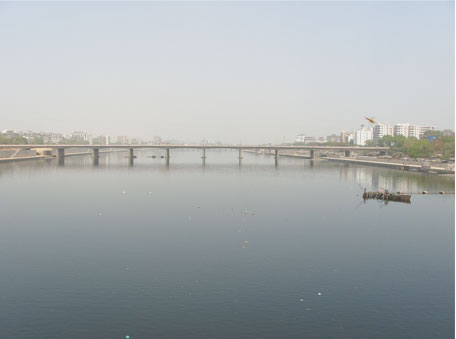
If we go further back, we find that during the 13th century, the ruler Pethasinh of Pethapur, ruled over the town of Shertha. After the demise of Pethasinh, the Sultanate of Patan used that area as a battle ground. The commonly called Ahmedabad dynasty, which in history generally appears as Muzaffarid dynasty, ruled over Gujarat from 1391 to 1583. During that period, Ahmedabad was established. It is also claimed that the location of the present Ahmedabad is same as where the city of Karnavati existed. Karnavati was founded by Karna Solanki between 1063 and 1093 AD on the banks of the Sabarmati River. Later, the city lost its glory and identity. It was then re-established by Ahmed Shah I.
The Muzaffarid dynasty was established by Zafar Khan Muzaffar (later called Muzaffar Shah I) in 1391. He was the Governor of Gujarat under the Delhi Sultanate ruled by Nasir-ud-Din Muhammad bin Tughluq IV. Zafar Khan’s father, Sadharan, was a Rajput who had embraced Islam and changed his name to Wajih-ul-Mulk. Zafar Khan Muzaffar had defeated Farhat-ul-Mulk near Anhilwada Patan and made the city his capital. Earlier to that, Farhat-ul-Mulk was made Governor of Gujarat in 1377 by Firoz Shah Tughlaq. Later, it was decided to replace him and Sikandar Khan was appointed as Governor of Gujarat by the Delhi ruler. But Farhat-ul-Mulk did not allow him to take his place. He defeated and killed Sikandar Khan.
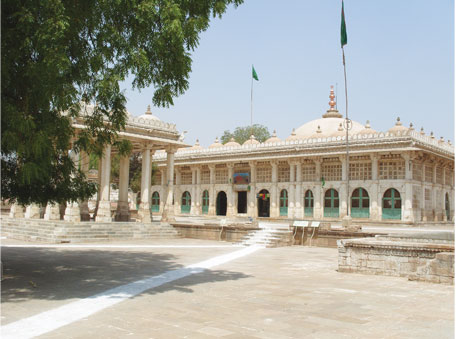
The rule of Mahmud Begada
The Sultanate reached its zenith during the rule of Mahmud Shah I Begada, the most prominent ruler of the Gujarat Sultanate. His name was Abu’l Fath Nasir-ud-Din Mahmud Shah I. He was popularly named as Mahmud Begada. Through his conquests, he expanded the Gujarat Sultanate to its maximum. He also conquered Malwa, and remained on throne for 43 years from May 1458 to November 1511. He founded a city called Mahemdabad (Memdavad) which is in Kheda district. Mahemdabad has some historical structures. One is Bhammariyo Kuvo (Kuvo means well), Chanda-Surajno Mahal (palace) and Roza-Rozi (mausoleum). People believe that Bhammariyo Kuvo is connected with Ahmedabad, Pavagadh and Junagadh through secret passages. The town is a popular tourist destination.
The Gujarat Sultanate began to decline by the 16th century. The Portuguese snatched Diu in 1509 after the Battle of Diu. Mughal Emperor Humayun attacked Gujarat in 1535. But he could not take Gujarat. Akbar took control of Gujarat in 1573 and made Gujarat a province. The last ruler was Muzaffar Shah III. He was imprisoned in Agra. In 1583, he escaped from prison. He could muster help from some well-wishers and regained Gujarat. But he was defeated by Akbar’s General, Abdur Rahim Khan-i-Khanan. During the Mughal period, Ahmedabad became Gujarat’s leading centre of textiles. It is also claimed that Emperor Jehangir had visited Ahmedabad in 1617 and found the city dirty! He called the city ‘Gardabad’, ‘City of dust’. But his son, Shah Jahan spent many years in Ahmedabad. He got the Moti Shahi Mahal constructed there. In 1753, the Mughal rule ended and the city went under the Maratha generals, Raghunath Rao and Damaji Gaekwad. The decline of the city was triggered due to a power struggle between the two.
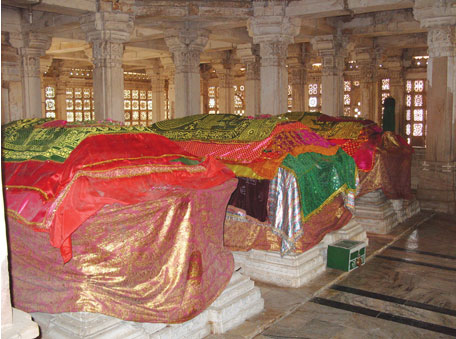
The city went under the British East India Company in 1818. In 1824, a military cantonment was established there. A major event of the 19th century was that a railway line was laid connecting Ahmedabad with Bombay in 1864. The railway link gave a boost to the city as a leading centre of manufacture and trade.
During the freedom struggle of India, Gujarat produced many leaders, most important being Mahatma Gandhi and Sardar Patel. India‘s Independence movement took its root in Gujarat in 1915. After Independence, Bombay state was split into two – Gujarat and Maharashtra, in 1960. Ahmedabad became Gujarat’s capital. Later, a new city called Gandhinagar was developed as capital of the state.
The city of Ahmedabad has a rich history. The same is reflected in the large numbers of historical monuments. The architecture of the buildings and monuments show a beautiful blend of Islamic and Hindu styles. The reason is that most of the monuments are from the 15th century.
Bhadra Fort
Among various historical monuments in Ahmedabad, the Bhadra Fort is well-known. The fort, built by Ahmad Shah I in 1411, is in the walled city area of Ahmedabad. The fort was developed as a township with palaces, mosques, open spaces etc. The fort had several gates, one of them was the Bhadra Gate. There is a belief that the fort was named after a temple of Bhadra Kali, a form of Laxmi. Also, some people claim that the fort was established during the Maratha rule, but history does not support the claim. During the past centuries, the fort remained neglected and suffered degradation. In 2014, the Municipal Corporation of Ahmedabad and the Archaeological Survey of India (ASI) renovated the fort and developed the area as a cultural centre.
A plaque near the fort tells visitors about the Bhadra Gate. The massive gate was built in or around 1411 by Sultan Ahmad Shah I as the principal entrance to the palace from the eastern side. The palace was named Bhadra after the ancient Rajput fort of the same name at Anhilwada-Patan.
Dada Hari Vav
Ahmedabad area regularly faced water shortage. During summer the area experienced high temperatures. To solve the problem, they built step wells. The wells provided water and also a cool, comfortable environment even during peak summer. Dada Hari Vav is one such well. ‘Vav’ means well. The Vav was built during the period of Mehmud Begda in 1501. Dada Hari Vav is a beautifully designed step well close to the tomb of Dada Hari. The Vav was frequented by travellers for cold water and for relaxation, especially during the hot summer.
Sarkhej Roza
At some distance from Ahmedabad, towards Gandhinagar, there is a large complex called Sarkhej Roza. The place was the home of a famous Muslim spiritual leader, Sultan Ahmed Shah, spiritual guide of Ahmad Shah I, the ruler who founded Ahmedabad city. He was also called Ahmed Khattu Gang Baksh. The area has several monuments, which date back to the time when Mughals ruled Ahmedabad. But the area became famous during the Gujarat Sultanate.
The area contains palaces, tombs, mosques, tanks and pavilions. The buildings surround a huge tank with steps to get easy access to water. The tank now remains almost dry most of the times of the year as the passages for water have been blocked by construction around the complex. Also, the area is facing encroachments from different sides.
The buildings at Sarkhej represent royal lifestyles of the time, as well as the religious and social life. The complex was used by the rulers as a country retreat. The tanks and pavilions formed the social link with people. The complex also houses tombs of the ruler Mahmud Begada and his queen. The architecture of Sarkhej Roza complex is beautiful, with lovely stone window carvings. Sunlight filtering through the intricate stone carvings generates a unique view. The complex has a small library with a good collection of religious and historical books and manuscripts. Large numbers of visitors throng the area, some for the tombs, others for the library, and still others to appreciate the architectural marvels.
Jhulta Minar
Ahmedabad is famous for its set of minarets made of stone. The minarets are part of the mosque Siddi Bashir. The minarets are commonly called Jhulta Minar. The minarets sway if a light push is given to the upper arc of the mosque. For visitors to Ahmedabad, the minarets are a place of fun and an example of a unique architecture and also a science puzzle. It has not been possible so far to decipher the mechanism which sways the minarets.
Teen Darwaza
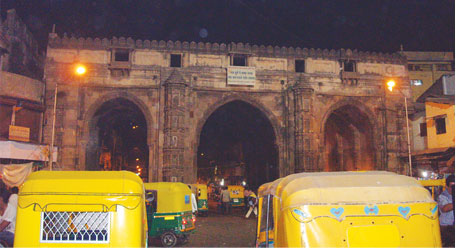
The architecture of Teen Darwaza is unique with fine Islamic architecture. The walls and pillars are beautiful with intricate carvings. The windows are of semi-circular shape with fine mesh work. The central window portrays the tree of life with five palm trees covered with snakes. This depiction now serves as the emblem of the Gujarat Government.
Sabarmati Ashram
The ashram is a very important building complex in Ahmedabad city on the bank of River Sabarmati. After returning from South Africa, Mahatma Gandhi established his first ashram in the Kochrab area of Ahmedabad on 25th May 1915. On 17th June 1917, the ashram was shifted to an open area on the banks of the River Sabarmati. Mahatma Gandhi wanted to start farming, animal husbandry, cow breeding, khadi production and other activities,to provide income and a living to common people. Hence, he selected the barren area. According to mythology, the place was the site of the ashram of Dadhichi rishi (a sage) who had donated his bones for a righteous war.
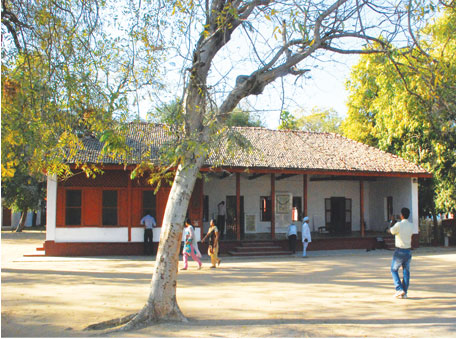
At the ashram, Mahatma Gandhi started a school that gave priority to manual labour, agriculture, and literacy, which he considered essential for self-sufficiency. During the freedom struggle, the government seized the property. Mahatma Gandhi decided to disband the ashram and it became deserted as large numbers of his followers were jailed. But some local citizens decided to preserve the ashram to keep alive the memory of Mahatma Gandhi. But he could not return to the ashram as he was assassinated in January 1948. Presently, the ashram provides detailed information about Mahatma Gandhi, his life, activities, companions and followers etc. The house where Mahatma Gandhi lived, called Hridaya Kunj, shows the simple life Gandhi led. The room where he used to work on the spinning wheel (charkha) is preserved with its charkha. Also, other belongings of Gandhi can be seen at Hridaya Kunj and in other sections of the ashram. The Vinoba Kutir and Mira Kutir are also part of the ashram. The ashram library is quite rich. There is a training centre too, where people learn various crafts.
Sidi Saiyyed’s Mosque
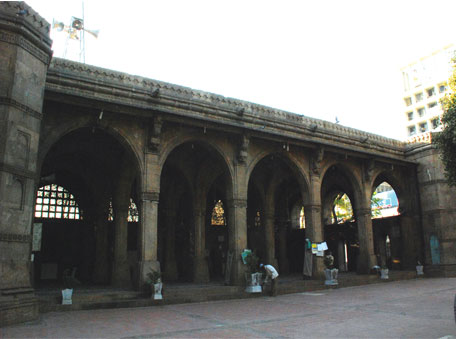
One of the jaalis is considered a symbol of love and friendship. When dignitaries visit the mosque, a small replica of the jaali is presented. When Queen Elizabeth visited Ahmedabad with Jawaharlal Nehru, a replica was presented to her. Visitors can purchase small replicas of the jaali from nearby souvenir shops. The same jaali has been used to create the logo of the prestigious Indian Institute of Management, Ahmedabad.
Calico Textiles Museum
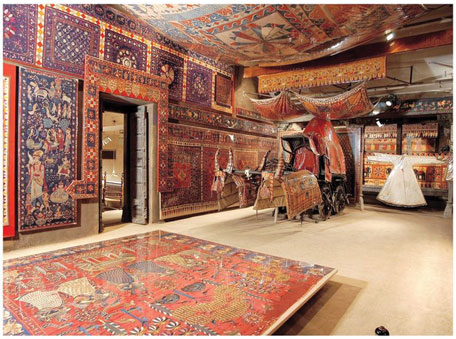
There are various other monuments and buildings in Ahmedabad. Recently, the banks of River Sabarmati have been developed and decorated beautifully with gardens, lights, walkways etc. Earlier, the river used to dry up in summer. But now, the water from the Narmada River reaches Sabarmati and the river remains full through the year, although some experts consider the arrangement un-sustainable.
Navaratri, Makar Sankranti and Diwali are major festivals celebrated in Ahmedabad. On the occasion of Makar Sankranti there is the famous kite flying. The markets and streets come alive, and kites in different colours and sizes are sold and other festivities are organised. Navaratri is another important festival, where garba dance is arranged at many places all over the city with the young and old dressed in ethnic clothes participating in large numbers. People prepare for garba competitions for weeks.
There is an interesting story about the history of Ahmedabad. The story is that once Sultan Ahmed Shah noticed that a little hare was chasing a big wild dog on the bank of the Sabarmati River. To understand the significance of the unusual incident, he inquired from a spiritual leader. The learned person explained that the land was unique and people of the area had rare qualities. Ahmed Shah was very impressed and he decided to make that place the capital of Gujarat Empire. Thus, the city was established and he named the city Ahmedabad.
Ahmedabad was the centre of the cotton industry during the Sultanate and continued to be so even later. In the 19th century, the city became an industrial hub. The first mill was established by Rancholal Chotalal in 1859. There was a time when there were 80 mills in the city. However, in recent years, many of them have closed. Also, Ahmedabad has been famous for gold jewelery, copper, brass items and wooden articles. Cloth embroiderers of Ahmedabad are well known for bead and mirror works.
Getting there
Ahmedabad is connected by air with Delhi, Mumbai, Kolkata, Chennai, Jaipur, Jodhpur, Aurangabad, Hyderabad, Patna, Srinagar, Vadodara and Bangalore. Ahmedabad is also connected through international flights. Ahmedabad is conveniently connected by fast trains with Delhi, Mumbai, Kolkata, Chennai, Agra, Bhopal, Jaipur, Jodhpur and Porbandar. Also, road connections are good and there are regular luxury buses from different cities to Ahmedabad. Taxis are available in plenty. The best period to visit Ahmedabad is winter, between November and March. Summers are hot.
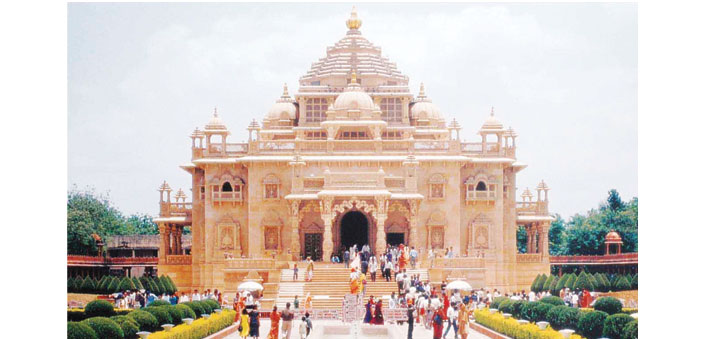
Gandhinagar
Gandhinagar, the new capital of Gujarat, is about 32 km from Ahmedabad, on the western side of Sabarmati. The city is linked with Ahmedabad by a wide road, with almost straight alignment. Earlier, Gujarat’s capital was Ahmedabad. But the city was congested and Gandhinagar presented a striking contrast with broad avenues, full of greenery. In 1960, Ahmedabad was made the capital of Gujarat state. The new capital city was planned and named after Mahatma Gandhi as Gandhinagar. Construction work began in 1965 and the secretariat started functioning there in 1970.
It is India’s second properly planned city after Chandigarh. Planning for Gandhinagar was done by architect H.K. Mewada, and his assistant Prakash M. Apte. Mewada and Apte had worked with the famous French architect, Le Corbusier, who designed the city of Chandigarh. They utilised their experience in planning Gandhinagar. The city streets are numbered, with cross streets named after the Gujarati alphabet letters. Various streets cross every one kilometre. The crossings have traffic circles which help in controlling the traffic speed.
In the centre of the city in Sector 10, there are the state legislature building and government offices. Vithalbhai Patel Bhavan, a magnificent building completed in 1982 houses the Legislative Assembly (Vidhan Sabha). Adjoining the Assembly, there are two multi-storeyed buildings housing government offices. There are 30 sectors in the city. Every sector has been planned in a way that it is self-sufficient with shopping and community centers, schools, health centres, government quarters and private houses. There are large parks, recreational areas and wide boulevards with trees.
Akshardham Temple
Although Gandhinagar is a new city, it has a few tourist attractions. Most famous is the Akshardham Temple of the Swaminarayan sect.The temple is spread over a large area. The main temple is an elaborately carved building constructed with pink sandstone. It is claimed that 6,000 tonnes of stone was utilised for the temple. The entire building has beautiful carvings and it is surrounded by manicured lawns, large numbers of trees and several beautiful fountains. It is said that about 1,000 artisans worked there for years to complete the structure. The temple runs a laser show which is quite attractive and well-planned.
Indroda Park
Indroda Dinosaur and Fossil Park is another place of interest in Gandhinagar. It is spread over 400 hectares on the banks of the Sabarmati River. The park is famous for dinosaur models and dinosaur fossils, and also includes a zoo, a large botanical garden, an amphitheatre, an interpretation center and camping facilities. Skeletons of marine mammals and other animals are kept there. The botanical garden is quite rich with large varieties of plants. The Wilderness Park has birds, reptiles, and also blue bulls, langurs, peafowls etc.
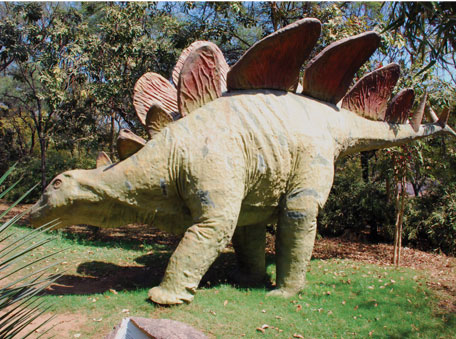
Adalaj step well
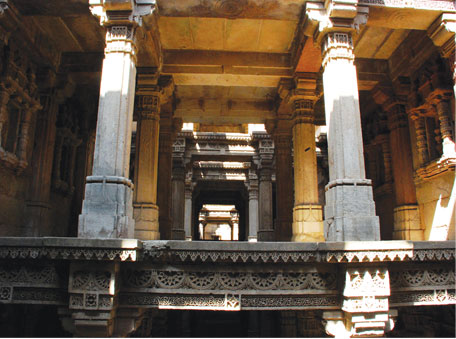
Craftsmen’s Village
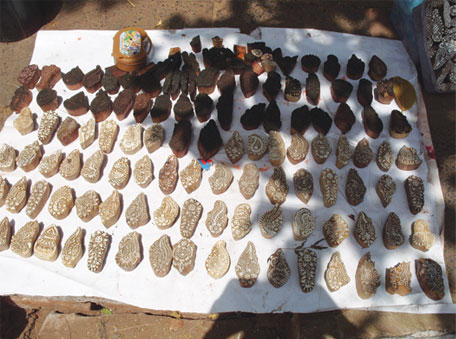
The beautiful garden named Sarita Udyan in Sector 9 is another place visited by many, especially on weekends.
Getting there People generally reach Gandhinagar via Ahmedabad, although Gandhinagar has its own rail link. People coming by road can reach Gandhinagar directly too.

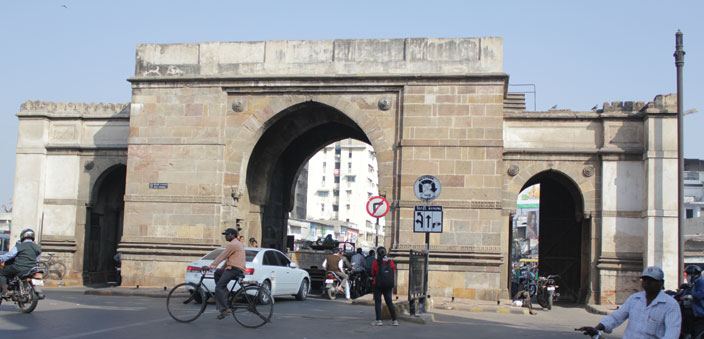
 [/column]
[/column]